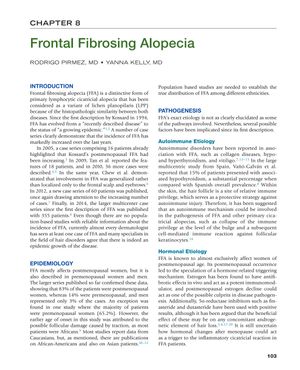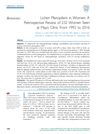Frontal Fibrosing Alopecia: Clinical Features, Diagnosis, and Treatment Challenges
July 2018
in “
Elsevier eBooks
”
Frontal Fibrosing Alopecia scarring alopecia eyebrow involvement autoimmune factors hormonal factors environmental factors clinical findings trichoscopic findings scalp biopsies hydroxychloroquine doxycycline antiandrogen therapy FFA scarring hair loss eyebrow hair loss autoimmune causes hormonal causes environmental causes clinical diagnosis scalp biopsy Plaquenil Vibramycin antiandrogen treatment

TLDR Frontal Fibrosing Alopecia is a type of hair loss affecting mostly older women, with no agreed best treatment.
The document from 2019 discusses Frontal Fibrosing Alopecia (FFA), a type of hair loss that primarily affects postmenopausal women, but also occurs in premenopausal women and men. It outlines the clinical features of FFA, including a band of scarring alopecia and eyebrow involvement, and notes the increasing incidence of the condition, suggesting it may be reaching epidemic proportions. The etiology is believed to be multifactorial, involving autoimmune, hormonal, and environmental factors. Diagnosis is based on clinical and trichoscopic findings, with scalp biopsies used for uncertain cases. Various treatments exist, such as hydroxychloroquine, doxycycline, and antiandrogen therapy, but there is no consensus on the most effective treatment and a lack of randomized controlled trials. The document highlights the challenges in monitoring disease progression and the need for a standardized grading score and further studies on treatment efficacy and safety.





